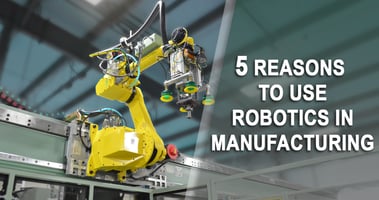Wauseon Machine's dedication to innovation and excellence in the automation industry has earned...
Risk Mitigation for Executives: Addressing Your Worst Fears About Automation Integration

No executive wants to think about the daunting possibility of experiencing an unsuccessful automation integration. When there’s so much time and money on the line, it’s paramount that the company’s investment in automated solutions performs according to expectations. Otherwise, you just might end up with nothing to show for your efforts but an unfortunate hike to the unemployment line.
That said, it’s a serious mistake to allow the fear of risk to hold your business back from reaping the immense bottom-line benefits of automation. Because those fears do NOT have to become your reality—if you take the right approach. With a solid strategy and experienced integration partner on your side, you’re equipped to systematically address each risk and access major profitability potential.
In this article, we’re helping executives see a clearer path to risk mitigation for adopting and implementing automation within their company. Here are four of the most common concerns for executives at the helm of an automation project, as well as critical insight for managing and minimizing these risks to achieve profitable outcomes.
The Risk of Investment Failure
For lots of executives, there’s the ongoing question of where to spend the company’s annual investment allocation, and one of the most common designations is capital equipment. The caveat here is that any investment in such equipment has to perform to ROI expectations, or you’re essentially tying up working capital that might be better leveraged for other areas of the business.
This is a validated fear. You now have the opportunity to make an investment in automation, with a substantial budget dictated by revenue and expenses. The money already exists, so it’s not necessarily the expense of buying automation that’s scary, but rather the opportunity cost to increase profitability. Because if it doesn’t work the way you expected, and you don’t see a profit from this decision, you’ve risked the chance to elevate your bottom line.
Here’s the good news: The risk of investment failure can be mitigated with a thorough automation audit by an experienced and reputable integration partner. Their only job is to design and build automated systems that fully align with your company’s business objectives, and they have years of experience doing just that. They know what’s really required to make automated solutions fit your business’s specific ROI model and business plan—which is exactly the guidance you require to see successful profitability outcomes.
The Risk of Lost Time (and Money)
You plan out the entire integration schedule and set a product launch date, but then the nightmare scenario happens: Your automation is late on delivery. Now, you’re dealing with ripple effects that impact timing, operating costs, and ROI. In fact, a significant delay could jeopardize the business itself. Because if you’re part of the supply chain and can’t deliver to your clients until months later, there’s a major risk of them pulling their contract. Or if you write your ROI equation factoring immediate delivery, and it takes the equipment four months to show up, your payback period now extends from two to two-and-a-half years. All of this means one very fundamental truth: Timing is important.
So when executives want to know what a realistic timeline for automation integration looks like, it’s important to reframe the question. There’s no one-size-fits-all schedule because every application is different. What you should be focusing on when you vet and select automation suppliers and/or integrators is whether they present schedules that identify critical milestones so you can identify and mitigate risk. That means if the start date is this and the end date is that, they need to be explaining WHY that’s the case in the form of critical paths. These critical paths make it that much more possible for you to set realistic goals that fit your business plan and reduce risk.
The Risk of People, Technology & Process Complications
Once the automation is installed, there is any number of complications that can impede a successful rollout, from the people using the equipment to the technology and processes involved in the integration. With your investment of resources already planted firmly into this effort, any issues that inhibit solid performance and tangible ROI are a formidable risk.
Maybe you don’t have the right training in place for the equipment users to execute optimally. Perhaps the technology doesn’t fit a specific function in the production or distribution line. Or it’s possible you didn’t have an inconsistent process, to begin with, and that’s throwing a wrench in capacity utilization and profitability. At the root of all these issues is a missed opportunity to work with an expert integrator that minimizes these risks through experience and know-how.
Unfortunately, not every entity that knows how to integrate an automated solution within a business operation has the distinct training, knowledge, and experience to do it well. Working with an integrator that doesn’t feature the necessary experience may make the price seem more appealing, but you risk ending up with a process that doesn’t meet your requirements or future complications that come with an unexpected price tag.
It’s important to remember that automation won’t create a process for you. So if you are looking for automation to define a process, you should be seeking integrators with core competencies in that area—ones who can simultaneously develop and automate your processes, ensure proper training and rollout, and set a course that meets your unique business objectives.
The Risk of Long-Term Operating Costs
These could be as simple as the costs of spare parts, maintenance, or downtime disruptions, but you have to factor them into the plan. You may find an automation product that checks all the boxes, in theory, only to find out after the fact that it comes with no service guarantee so it’ll take weeks to fix a problem. In a case like this, perhaps spending 25% more on a piece of automation that can get fixed in 24 hours is worth it in the long run.
There are quality automation integrators out there with a service-for-life mentality, that are able to support remote troubleshooting, preventative maintenance, predictive maintenance, a spare parts list, etc. If you’re worried about the risk of long-term operating costs, this is a vital factor. Find a partner that can serve as an extension of your maintenance group to ensure that your equipment performs according to plan over its lifetime.
Download 7 Ways Automation Makes Manufacturers More Competitive to learn more about gleaning a competitive edge with manufacturing automation.


